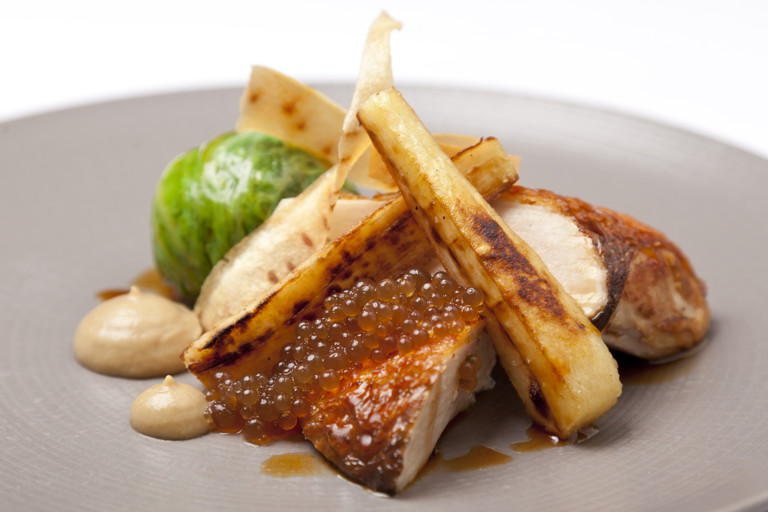Poached and roasted pheasant with Savoy cabbage, roast parsnips and sherry vinegar pearls
Item 1 of 1
- medium
- 4
- 3 hours 30 minutes
The inventive sherry vinegar pearls add an impressive touch to this classical pheasant dish from Andy McLeish. This poached and roasted pheasant recipe is a great option for autumn and winter, when pheasant is widely available and parsnips are at their best.
First published in 2015
discover more:
Ingredients
Metric
Imperial
Poached pheasant
- 2 hen pheasant crowns
- vegetable oil
- salt
- pepper
Sherry vinegar pearls
- 100ml of sherry vinegar
- 1.5g of agar agar
- 10g of sugar
- 1.13l vegetable oil, chilled
Savoy cabbage
- 1 savoy cabbage
- 1 shallot, finely sliced
- 1 pinch of fresh thyme
- 1 garlic clove, chopped
- butter
SAVE RECIPE
Equipment
- Blender
- Fine strainer
Method
1
To make the pearls, boil the vinegar, agar agar and sugar together until dissolved and pass through a chinoise
- 100ml of sherry vinegar
- 5g of agar agar
- 10g of sugar
2
Pour into a plastic squeezy bottle with a fine nozzle. Gently pour into the chilled vegetable oil and let the pearls set. Strain off the oil and wash under cold running water, storing in the fridge until ready for use. The vegetable oil can be used again as normal
- 1.13l vegetable oil, chilled
3
For the parsnip purée, peel the parsnips and cook them in gently boiling chicken stock until tender, around 15-20 minutes
- 5 parsnips
- 2.27l chicken stock
4
Remove them from the stock and blend 3 of the parsnips in a food processor. Add half of the cream and a little of the stock (reserving the rest for poaching) and blend until silky smooth. Season with salt, pepper and lemon and pass through a sieve. Place in a small pot, cover and set aside
5
Take the 4 outer leaves from the cabbage and blanch them in boiling salted water until tender. Then finely slice the rest of the cabbage to its core. Blanch the sliced cabbage until tender, around 4-5 mintues, strain and remove all the water by gently squeezing the cabbage
6
Cook the shallot in a pan on a medium heat with a little butter and add the remaining cream with the thyme and garlic. Reduce slightly and add the sliced cabbage stirring to combine. Season to taste with salt and pepper and cool in the fridge
- butter
- 1 shallot, finely sliced
- 1 pinch of fresh thyme
- 1 garlic clove, chopped
- 50ml of cream
7
Once cool, shape the sliced cabbage into 4 equal balls and wrap each one in the cabbage leaves, then wrap tightly in cling film to hold the shape
8
Bring the chicken stock to the boil in a pan. Once boiling, remove the pan from the heat and place the pheasant crowns into the stock, cover and leave for 10 minutes
- 2.27l chicken stock
- 2 hen pheasant crowns
9
Preheat the oven to 180°C/gas mark 4
11
Repeat to cook the crown on the other side and place in the oven for a further 6-8 minutes
12
Warm the cabbage balls in some boiling water for 4 minutes, then remove and cut off the clingfilm. Cut and then pan-fry the remaining parsnips in a little butter until golden brown. Remove the pheasant from the oven and leave to rest for 5 minutes
- 1 knob of butter
13
Re-heat the parsnip puree, cut the pheasant from the crown and place onto the plate, adding the roast parsnip, hot cabbage balls, parsnip puree and sherry vinegar pearls. Add some of the juices from the pan that the pheasant was cooked in just before serving
Get in touch
Please sign in or register to send a comment to Great British Chefs.



